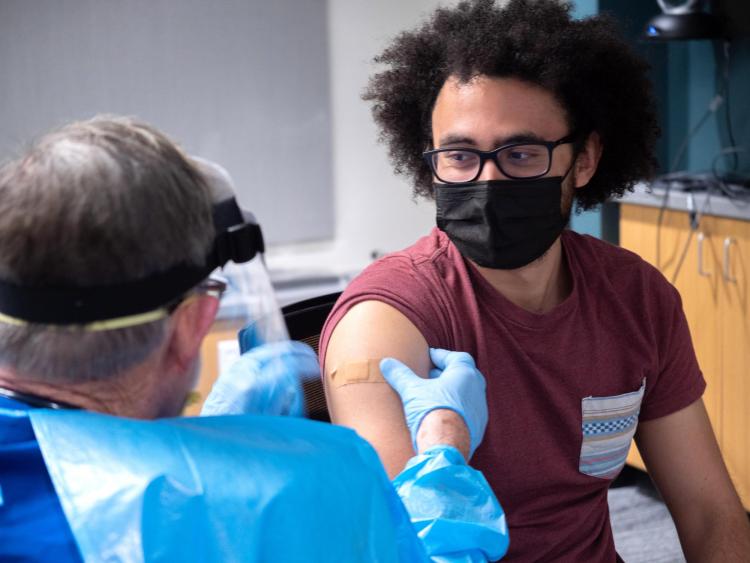To safely return to ‘normal,’ 70% of Coloradans must get COVID vaccine
At least 70% of Colorado residents will need to get vaccinated against COVID-19 before the state can safely roll back all public health restrictions and return to “normal.”
Those results come from a new mathematical study led by researchers at two University of Colorado campuses—CU Boulder and the CU Anschutz Medical Campus. The team explores what it might take for the state to safely shed mask mandates, limits on indoor dining and a range of other restrictions.
The findings, published online as they await peer review, indicate that Colorado is heading in the right direction, said study coauthor Andrea Buchwald, a research associate at the Colorado School of Public Health at CU Anschutz. But residents still have a lot of work ahead of them.
“Everyone likes to talk about how we’re almost there, that we’re in the endgame,” said Buchwald. “But we have to make a shared decision as a society to get vaccinated if we want to get back to this idea of normal.”
Buchwald and her colleagues used state-of-the-art modeling tools to simulate how COVID-19 might spread throughout the state in the months ahead under different scenarios—balancing how Coloradans could potentially relax their precautions while also keeping people out of hospitals. The work was funded by the AB Nexus, a CU effort that seeks to spur collaboration between CU Boulder and CU Anschutz.
It highlights the close connections between Colorado’s rural areas and urban centers, said study coauthor Emiliano Dall’Anese, assistant professor in the Department of Electrical, Computer, and Energy Engineering (ECEE) at CU Boulder. If a few counties rolled back restrictions too early, the study found, they could easily kick off a wave of infections across the entire state.
“We wanted to examine what would happen if one region decided to open up too quickly,” Dall’Anese said. “How would that impact other regions?”
The study was led by Gianluca Bianchin, postdoctoral researcher in ECEE, and included coauthor Jorge Poveda, assistant professor in ECEE.
Modeling the pandemic
Mathematical simulations, or models, have long been an important weapon in the fight against COVID-19. Buchwald, for example, has served for more than a year on Colorado’s COVID-19 Modeling Team, a group of scientists from multiple Colorado universities who have worked to inform the state’s public health decisions—with math.
“Over and over again, the biggest question that we got at many different points during the pandemic was, ‘OK, when can we start eliminating these restrictions?’” Buchwald said.
The latest study, which wasn’t an official effort of the Modeling Team, seeks to answer that question. In it, Buchwald, Dall’Anese and their colleagues employed a new mathematical approach called “online optimization of dynamical systems” to put different strategies for easing restrictions in Colorado to the test. In other words, how much could Colorado cut back on its public health guidelines, and when would it be safe to remove interventions entirely, without leading to yet another spike in COVID-19 hospitalizations?
Dall’Anese noted that the team didn’t examine the efficacy of individual restrictions, such as mask mandates, on their own but, instead, looked at their collective impacts.
“This preliminary work is an assessment tool of sorts where we can set goals for the maximum number of people infected and in the hospital and see how the pandemic evolves,” he said.
Vaccinating Coloradans
And, the team discovered, vaccination rates may make a big difference in that evolution.
Say, for example, that Colorado wanted to keep infections low enough that, at any one time, no more than 500 people would have to be hospitalized because of COVID-19 complications. (Current numbers hover around 600). If the state vaccinated 15,000 people per day, it could begin to ease back some public health restrictions immediately without going over that limit. But it couldn’t safely remove all restrictions until well into 2022. If 25,000 people lined up for vaccinations every day, in contrast, the magic date for returning to normal could fall around October 2021.
During the week of April 11, more than 55,000 people per day, on average, in Colorado received their first or second COVID-19 vaccine—but whether the state can keep those numbers high remains unclear. To force hospitalizations even lower, Buchwald noted, at least 70% of Coloradans would need to get vaccinated.
“Right now, individuals under 16 aren’t even eligible to get the vaccination, and they make up a substantial portion of Colorado’s population,” Buchwald said. “Vaccine uptake among eligible populations has to be really high for us to reach 70% of the population.”
The general findings proved true for all portions of the state, the team found, even in more rural areas like the San Luis Valley. In the team’s models, if these parts of the state rolled back public health restrictions entirely, and individuals returned to pre-pandemic behavior, almost all of them could see an immediate surge in COVID-19 hospitalizations. In some cases, those surges might trigger similar spikes in infections in Colorado’s more metropolitan areas.
Dall’Anese added that models aren’t perfect. They don’t, for example, account for the more infectious COVID-19 variants currently spreading around the globe. But, he said, his team has been grateful for the opportunity to put its mathematical savvy to use to help out real Coloradans.
“Personally, I found this very rewarding,” he said. “The pandemic has allowed us to sit down and really think about how we could use our knowledge to solve real-world problems and even save lives.”



